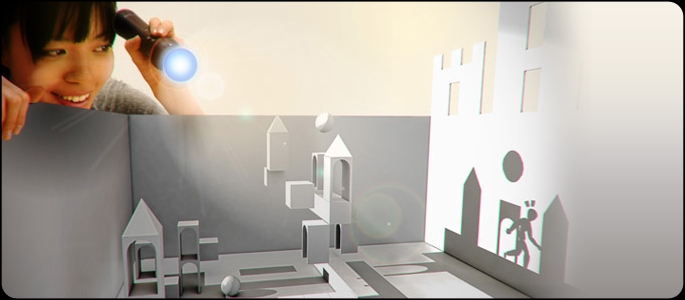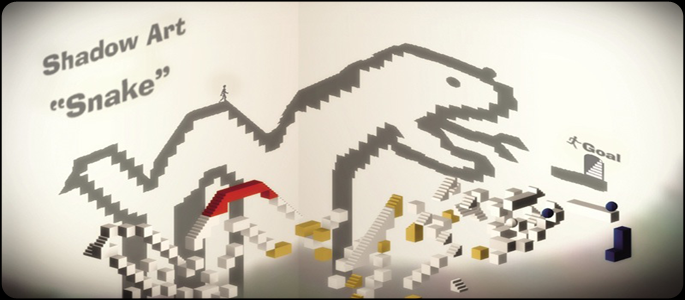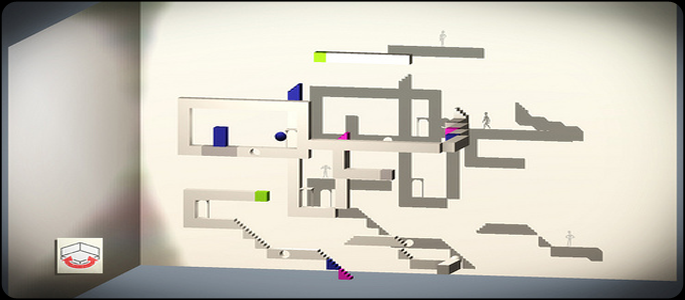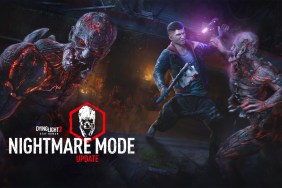As the followup to one of the most beautiful and innovative titles on the PSN, echochrome ii takes puzzle solving to a new level with the inclusion of the PlayStation Move. Is Japan Studio’s latest brain-teasing title worth the trouble?
Announced at E3 2010, echochrome ii is the aptly named sequel to the original echochrome, the M.C. Escher-inspired minimalistic title with “the least graphics and the most gameplay.” The player was in control of moving the environment change the view of pathways to remove or create obstacles, and with no set time limits the game had a very relaxing and surreal ambiance. The sequel has a very similar omnipotent feeling to it but puts the player in a much more proactive position. Using the PlayStation Move controller as a flashlight the player casts two-dimensional shadows across three-dimensional objects to create a flowing plane for the Shadow character to walk across.
echochrome ii was designed to demonstrate the fullest capabilities of the PlayStation Move but, while it doesn’t exactly do that, the game still works very well. While the game has been portrayed as shining a flashlight through the television into a virtual room, the reaction time of the game doesn’t feel as true one-to-one as it should be. It actually turns out the the PlayStation Eye camera isn’t used at all for the game, it is merely used to record video (more on that later). The pointer controls as well as the flashlight are controlled solely through the Move’s internal accelerometer. You can be completely out of range of the PS Eye’s range of view, such as across a room, and still control the light. While this may seem like a problem, it actually helps with the game’s aesthetic feeling.
Originally, it seems like something to complain about. But that much control would probably hamper the game’s approachability. Even with the sensitivity turned up high, the light seems to drag across the screen than simultaneously with the movement of the player’s hand. But the majority of echochrome ii doesn’t require such incredible subtlety and in fact, if you try to move fast, you might accidentally bump your “shadow” off its block to his demise. It is designed to slow the player down and play more with strategy and thinking, as opposed to reaction and dependency. With this, echochrome ii creates a new level of immersion within the player’s own mind, rather than stemming from the exploration of the environment. Once you accept this fact, the game becomes much more enjoyable.
The real meat of echochrome ii comes from the level variety. Not only does the title have one hundred developer-created levels, but along with the nearly limitless amount of user-generated levels, each stage can be played in three different ways. “Escort” mode is the mode available on the PlayStation Network or PlayStation Move Starter disc and is what you are more familiar with. By casting the shadows over the environment, you move the character across the room to the exit, possibly one of a few. Exits are created by placing the shadow of a sphere on top of two cube shadows, creating an arching doorway. Depending on the angle of the flashlight, the design of the level, and the player’s own intuition, there can be several different exits in a stage.
“Echo” mode is just like the original echochrome where you must use your shadow to collect various echos across the stage. “Paint” mode is where echochrome ii begins to innovate, rather than merely redesign the former game. In this mode, there is no official “exit” to the stage. Using three new colored characters, you are required to traverse the shadows to color their corresponding blocks. The level is only finished after a certain percentage of the blocks are painted, leaving the path to completion completely up to the player. One of the major attractions to echochrome ii is also moving the light source around and discovering the pieces of Shadow Art within the different stages. I’ve only come across a few of the art pieces so far in the game, sometimes two in each stage, so I don’t know if there is some in every level. Sometimes the game can really get frustrating so it’s definitely suited for small doses. A fresh view a day, or even just a few hours later can really change the perspective on a level.
echochrome ii‘s music is very similar to the first game, mainly the orchestral strings, but it feels fresher and livelier. Bubblier even. While it totally fits the game and adds to its appeal, similar to the original echochrome, the music loops across each level and even fans of the style will eventually get tired of the repetition. Also like the first game, echochrome ii lets you upload the footage of your stage to YouTube. Interestingly though, you can also choose to upload footage of yourself behind the actual stage. It seems like a neat concept, but the PS Eye isn’t that great of a camera and with the level of thinking required for some of these levels, looking good on camera will be the last thing on your mind.
All in all, echochrome ii is definitely a worthy sequel to its predecessor. While most people will initially complain at the exact implementation of the PlayStation Move support, this title definitely deserves the title of “The Thinking Man’s Game.” It puts players in a position not seen in most games, entirely proactive and in control of the environment. Some players may not like the slow pace of the game, but those who do will find nothing better. The levels do get quite unforgiving later in the game, but the sense of satisfaction in entirely unparalleled. While echochrome ii may not make you go out and get a Move controller, is definitely worth playing if you have one.
PlayStation LifeStyle’s Final Score
+ The level design is static, but can change depending on the player. + Tons of replay value and “collectibles.” |
 |
–











